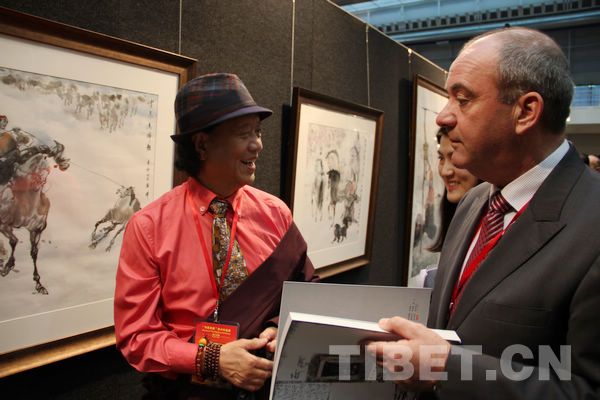Witnesses denounce claims of "cultural genocide" in Tibet

Photo shows an artwork displayed during the "Beauty of Tibet" Painting and Photography Exhibition held in Australia. [Photo/China Tibet Online]
The "Beauty of Tibet" Painting and Photography Exhibition was opened in Australia on May 29, 2013, providing a window for locals and global audiences to get a better understanding about Tibet.
During the exhibition, audiences saw the developing, harmonious and beautiful Tibet. However, they raised questions to the experts and scholars in the art delegation: why what they have seen from the exhibition is different from what the Dalai clique and the Western society preach?
The 14th Dalai Lama always claims the "cultural genocide" of Tibet, criticizing the central government of China for "radical restriction of Buddhism lectures", the Tibetan "culture, language and ethnic identity on the verge of extinction" as well as the "assimilation of the Tibetan culture by the Han culture".
Shi Weiqiang, consul general of Chinese Consulate in Melbourne, had worked as an aid-Tibet cadre for three years from 2001 to 2004, during which he went to the Barkhor Street every morning to take pictures of the local pilgrims taking ritual walks.
"Since the peaceful liberation of Tibet in 1951, the Tibetan culture has entered the best phase of development. I learned that the local government of Lhasa allocated money to build stoves for local Buddhist followers to burn aromatic plant as a way of protection for the locals' Buddhist life," said Shi.
Compared with China, some Western countries have great differences in national conditions and development patterns, so they misunderstand China's policies in Tibet. For example, the one-on-one aid project of more advanced provinces is a Chinese tradition to aid the less developed areas of China. However, the project and aid-Tibet cadres are defamed as implementation of "Assimilation of Tibet".
The friendship between the Hans and Tibetans can be dated back to over 1,000 years ago when the well-known marriage of Princess Wencheng of the Tang Dynasty (618-917A.D.) and Tibetan king Sontzen Gampo started, Shi Weiqiang said.
"When I was in Tibet, I got along well with the locals and learnt a lot from them, which was normal cultural exchange without any imposed ideology, let alone 'Assimilation of Tibet'. It's a pity that some Western countries always are often biased toward Tibet," said Shi Weiqiang. "I hope more Western people and scholars will come to Tibet and see the truth by themselves."

Nyima Tsering, a first-class artist in China, talks with a senator of Australia during the "Beauty of Tibet" Painting and Photography Exhibition held in Sydney. [Photo/China Tibet Online]
Nyima Tsering, the Tibetan painter for the 10th Panchen Lama and first-class artist of China, expressed the same opinion.
Nyima Tsering's teacher in Central Academy of Fine Arts in Beijing once advised him to focus on ethnic culture, inheriting and developing it by what he had learnt. Therefore, among the Tibetan artist's works, there are traditional Thangka paintings as well as modern paintings reflecting the ordinary people's life.
"A stagnant ethnic group is bound to be obsolete as time goes on, because protection means development, and development is the best way of protection," said Nyima Tsering. "If our culture were extinct, those people who claim it should come to Tibet and have a look by themselves."
Michael Henss, a Swiss scholar who has made numerous field investigations in major Tibetan monasteries for 26 years, is a witness of the cultural, religious and social development in Tibet.
He is glad to see many main or once neglected monasteries are now under good preservation and inheritance with proper renovations since the 1980s.
"I think that much traditional Tibetan culture has survived. Now the situation in Tibet is definitely getting better, which the Dalai Lama couldn't deny," said Michael Henss.
According to the Chinese Academy of Social Science, Lhasa has been awarded China's happiest city for six successive years. We can imagine, if an ethnic group's culture is "extinct" and religious belief is "oppressed", how can its people be so happy?
Your Comment
Name E-mailRelated News
-
;
-
-
Chinese economy shows 'strong fundamentals', says ex-Australia PM
Despite foreign and domestic challenges facing the Chinese economy, including the recent turbulence in the stock market, former Australian prime minister Kevin Rudd has full confidence in the world's second-largest economy.
-
-
-
Australian Deputy Consul-General:"I never thought Tibetans could sing English songs"
Australian Deputy Consul-General in Chengdu Mr. Erbacher was stunned by the changes of the Tibetan-inhabited areas in Sichuan when he got there ten years later.
-
-
-
Australia vows to protect foreign missions in wake of Chinese consulate break-in
Australian police on Thursday apologized for failing to prevent a break-in of the Chinese Consulate General in Sydney a day earlier, pledging to reassess its security contingency plan for foreign diplomatic missions.
-
Based in Lhasa, Tibet Vista is a Tibet travel agency that specialized in Tibet permit, and Tibet tours for both private and group travelers at a local price!
•4 Days Lhasa City Group Tour from USD 460 •8 Days Everest Base Camp Group Tour from USD 850 •15 Days Mt.Kailash Group Tour from USD 1780 •2016 Tibet Train Tours from Beijing, Shanghai, Chengdu, Xining,etc










